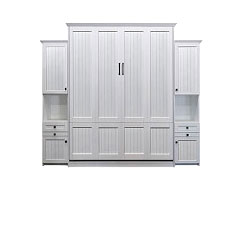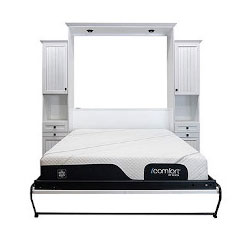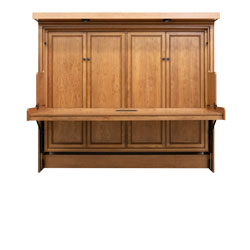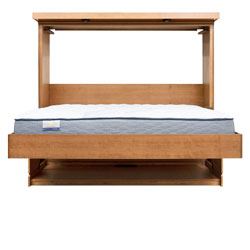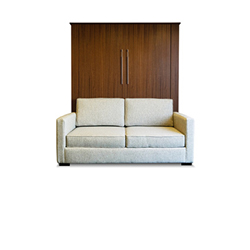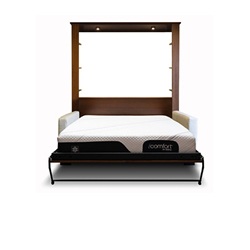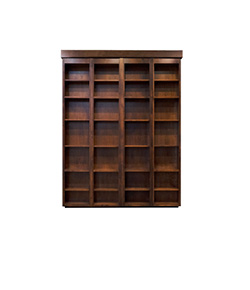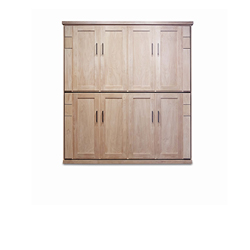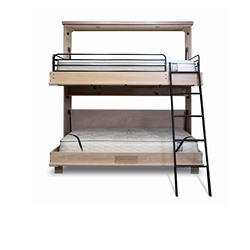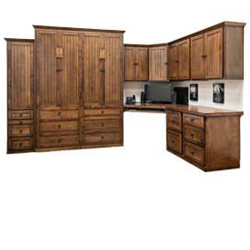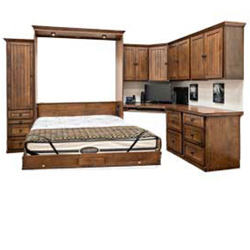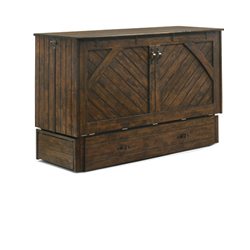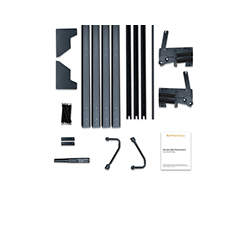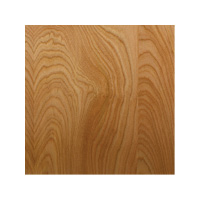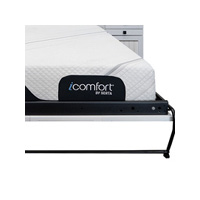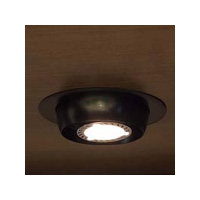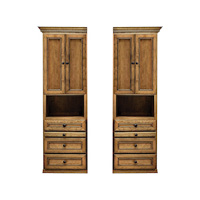How to Make a 5 Piece Door
Wilding Wallbeds makes nearly all of their cabinet doors and bed panels in house. Wilding uses the 5 Piece doors construction which is a method developed to help with the expanding and contracting of wood due to humidity. The panel is inserted into grooves that are on the inside edge of the stiles and rails. The panel is also cut smaller that that opening, which will allow the panel to float. When the panel expands it will have room to do so and not affect the integrity of the door. I will be going over the steps to make a 5 piece door. Just remember this is the technique used by Wilding Wallbeds; the machinery and techniques may not be the same as yours.
Parts of a 5 Piece Door
The five pieces in a 5-piece door are the four parts of the frame, called stiles and rails. The stiles are the vertical sides, and the rails are the top and bottom pieces. The fifth piece is the panel, which the stiles and rails surrounds.
 |
| Panel |
 |
| Stiles |
 |
| Rails |
Step 1: Choosing and Milling the Material for your Door
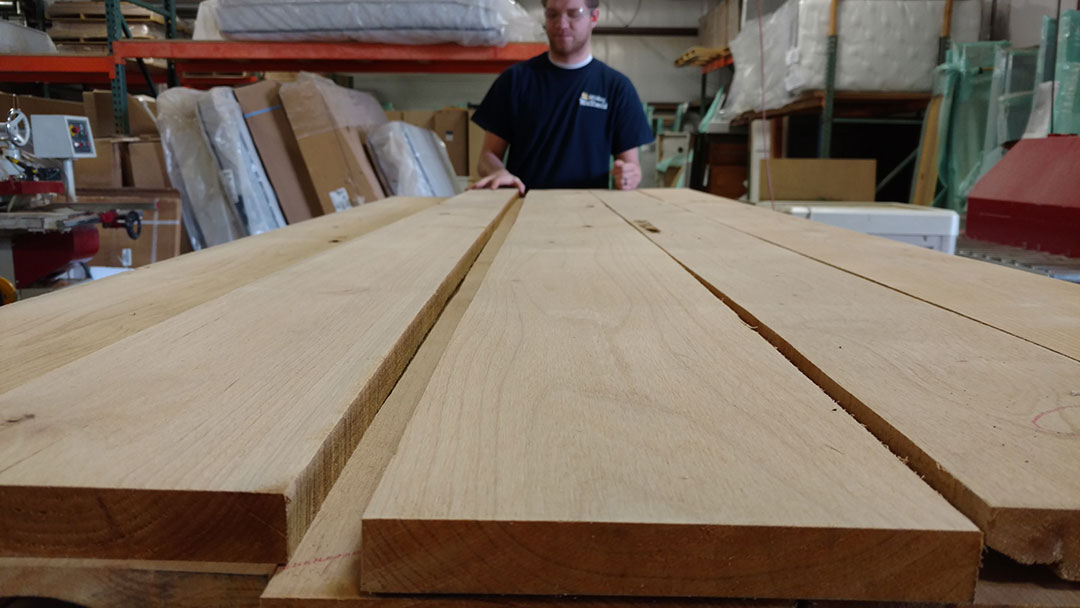
When choosing the material for your door you will most likely look at several different boards. You will want material that has no twisting to it or at least very mild twisting. You will want to look at the color and grain of the wood. After you have selected the material that you will need, set the material for your panel aside as you won’t be milling that yet. The material for your stiles and rails can be ripped down to the proper width. Now run the material for the stiles and rails through a planer or a moulder to get the desired thickness. All of our material finishes at 13/16″ thick.
Now go back to the material that was set aside for the panel. When cutting the material for the raised panel, Wilding Wallbeds follows a few guidelines. First we use material that is no more than 4″ wide. Second we look at the color and the grain of the board and try to match it as close as we can. Finally, when choosing the material for the panel we look at the end grain of a board to see what the direction the growth rings are going. When looking at the end grain, notice the growth rings they usually curve up or down (see illustration below). We alternate the growth rings when gluing panels. Alternating the growth rings won’t stop the cupping but, by doing so, cupping will be minimal.

Remember the wider the board the more likely it is to cup. If we have a board that is 8” wide we will cut it in half and then use it in a panel. So if your panel has narrow strips it will be more stable than a panel with wide strips.
What is cupping? Cupping is when one side of the board shrinks more than the other side. If you look at the growth rings your board will cup in the opposite direction of the growth rings (see illustration below).

Step 2: Raised Panel

Let’s start on the raised panel. Take the material for your panel and rip it down to the desired width. At Wilding Wallbeds, we do not use material over 4” wide as we have learned, the narrower the board, the more stable it will be. You will also want to add 2″ to the width and the length of the panel. This 2″ will allow you to square the panel on the saw.
You now have the material cut to the proper width and length. You can now glue up your panel . Remember to look at the end grain and make sure you have alternated the cups of the growth rings. After the panel has been glued and clamped for an hour you can plane the panel down to 13/16″ and cut it to size. After it is cut to size you are ready to run it through the shaper with the raised pane knife set.
Step 3: Rails

It is very important that you take your time and make sure to get the coping and the sticking knives set up correctly. You want a nice flush joint when you join the stiles and rails. This will require some time and some scrap wood. We use a programmable shaper. We enter the program and it automatically sets the height and the fences. We will run a calibration test on it every morning before we start.
The rails are on the top and bottom of the door. The rails go through both the cope cut and the sticking cut . The cope cut is on the ends of the rail and it is very important to keep your rail pressed down tight and you make a square cut. If you don’t get the cope cuts square and straight, then your door will not go together correctly. However you make these coping cut you will want to use a hardwood backer block to prevent blowouts as you are finishing your cut as these cuts are against the grain. After you have made your coping cuts you will want to make the sticking cut. For this cut, make sure you get a good clean straight cut, as this is the cut that will receive the raised panel. Remember this cut needs to be done after you have made your coping cuts.
We use a sled with a pneumatic clamp. This sled insures us that we are getting a nice clean. straight, square cut. To help make sure we get a good cut we add 1/8″ to the length of the rail and we have our shaper set up to remove 1/16” per pass. If your rail starts out at 12”, it will become 11 7/8″ long, after running the rail through the coping knife.
On the sticking cut we have a feeder that keeps the board pressed down tight on the table and holds it tight to the fence. Because the sticking cut is with the grain you will not need a backer block. Just like the coping cut we also have our sticking knife set to remove 1/16” from the width of the rail.
Step 4: Stiles

Make a test cut before you start. It is better to waste a piece of scrap wood rather than a pile of material.
The stiles are the side of the door. They will have the sticking profile cut on them. You will not need a backer block when running your stiles because this cut is going with the grain not against.
Now that the rails and stiles are shaped you are ready for assembly.
Step 5: Assembly

Assembling the door is a straightforward process. You will want a good clean flat area to assemble the door. At Wilding Wallbeds we use a Ritter Door Clamping System. This system has a squaring bar and fence. The table looks like pegboard so all the pneumatic clamps are adjustable.
It is a good idea at this point to dry fit your parts and check the size of the door. If you need to adjust a part size now is the time to do it, because once it is glued, it is a lot more difficult to fix a mistake. Things that you will want to look for when you are doing the dry fit is the stile and rail joint. That joint should be tight. Once you are happy with the results take it apart and add the glue. Use a good glue bottle with a small tip. If too much glue is added it will make a big mess. If glue squeezes out and sets on the material without being completely removed, it will affect the finish on the door. Take one of the rails and apply the the glue to 3 areas of the rail end (see drawing below).


Reassemble the door and place it in the clamps. Remember that it will not need a lot of pressure you just need enough to close the joints. Take a rag and wipe off the excess glue and making sure the door is flat. When we are building more than 2 doors we place 2 or 3 small 1/2″ pins in the joints to hold them tight while the glue dries.
Wilding Wallbeds likes to use space balls in our doors . Space balls are little rubber balls that have a diameter of a 1/4″. We add 2 space balls per rail and stile. On the stile you will want to keep them about 4″ from the ends so the rail won’t hit them. We use space balls to keep the panel square and they are rubber allowing the panel to expand and contract. They’ll also help reduce the amount of rattle the panel can make.
Step 6: Sizing
We purposely oversize our doors so we can trim about 1/16” from each side of the door. This gives a nice clean straight edge that we can apply the outside edge profile on. The outside profile is also done on a shaper. When shaping the top and bottom of the door use a backer block, because you are going against the grain on the ends.
Step 7: Finish Sanding
All of the doors are run through a surface sander a couple of times on each side to get them to ¾” thick. Now that the doors have passed through the surface sander and are nice and flat we sand the front and back with an orbital sander using 120 grit sandpaper. The edge profile is sanded with the orbital and the detail is hit by hand.
Written by Karson White
Technical Shop Drawings and Design
